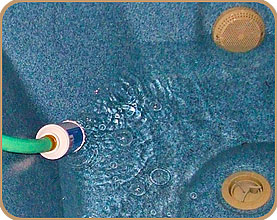Test & Balance Hot Tub Water
I know some people who claim to have "perfect" spa water right out of the tap - "I don't even need to test it," they say.

That may be true for some people, but for the majority of spa owners, the water from the tap or hose may have very low levels of calcium, alkalinity, pH. Well water can also contain loads of minerals and metals, and city water can be full of chloramines and other water treatment byproducts.
When filling a spa after draining, you start fresh again with "new" water. What follows is a step-by-step on how to test and balance spa fill water, to make it perfect for hot tubbin'.
1. Pre-Filter the Water
For well water, this is a must. "Yeah, but my well water goes through filters and a conditioning system," you may say. But did you know that most outdoor hose spigots are not connected to a home water treatment system? Only kitchen, bath and laundry. You can fill a hot tub from a utility sink if you have a faucet adapter, or you can just screw a pre-filter onto the end of the garden hose. A spa pre-filter traps minerals, sediment, and other junk that you don't want in your spa water.
For city water too, a pre-filter will remove sediment and impurities. Even if your tap water looks good and smells good, filtering it as you fill the hot tub will improve the water quality and make your spa water easier to manage.
2. Check Calcium Hardness
The first step after refilling a spa or hot tub is to check the hardness of the water. Test strips can be used, but a liquid test kit is much more accurate. For hot water spas and hot tubs, water that is too soft can foam easily. Soft water is also aggressive and corrosive to pump seals and o-rings and shiny spa finishes. Spa water that is too hard can cloud easily and deposit scale around fittings and at the water line. For spa water that is too soft (under 200 ppm), add Calcium Increaser to raise the level and make the water "harder." For water that is already hard (over 400 ppm), common in many parts of the country, well - we don't have a chemical to lower calcium hardness. However, using the pre-filter can lower total hardness by several hundred ppm. Spa hardness is best in the 180-220 ppm range.
3. Check pH & Alkalinity
Total alkalinity measures the carbonates and bicarbonates in the water, which act as a buffer to pH change. If your pH "bounces" or changes easily, you likely have low alkalinity. If your pH is resistant to change, you likely have high alkalinity. For spa water with low alkalinity (under 80 ppm), add Alkalinity Increaser to raise the level. For water with high Alkalinity (over 150 ppm), use the pH Minus chemical or other acid to lower the level, which will also lower your pH somewhat. After filling the spa, adjust alkalinity to the 80-120 ppm range. Spa pH should be in the 7.2 - 7.6 range. A proper pH helps bromine and chlorine work their best, and good pH also helps prevent damage to seals, o-rings and surfaces. If your tested pH is too high, add an acid (pH Down), and when it's too low, add a base (pH Plus).
4. Add Bromide & Bromine
One disadvantage to dumping the spa water every 3-4 months is that you lose your bank of bromide ions. Bromine, unlike chlorine, takes a while to build up a "bank" of bromide ions. It can take several weeks of waiting for bromine tablets to dissolve, shocking every few days - or the faster recommended method is to add some bromine booster to the spa. Just a few capfuls of Brom Booster brings up the level of bromide ions, so that you can see some results when you test the bromine level. After adding bromides to the spa, fill the spa floater or brominator with half a dozen 1" bromine tablets. Test the bromine level over the next few days. Your spa may need slightly fewer (4) or slightly more (8) bromine tablets to register a consistent 3-4 ppm bromine reading.
After all of that work, you're ready for a dip in the tub! Here's one more TIP: write down exact quantities of what you need to add to fresh fill water. Chances are, your source water will stay fairly stable and consistent in its chemical balance, so write down exactly what you need to add to make it easier on the next refill.